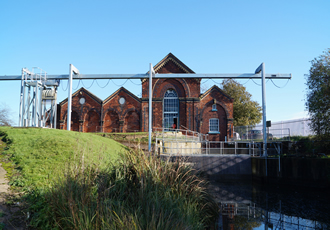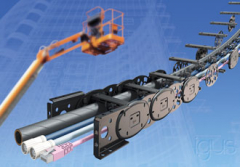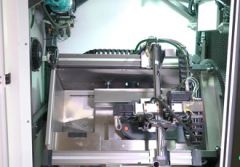A guide to specifying weed and trash screens

Flood defence schemes and drainage systems depend on the unhindered flow of water, either using gravity or with the assistance of a pumping station. In either case, a properly specified and designed screen can provide an invaluable defence in preventing blockages and debris from damaging pumps.
Jamie Wesley, Commercial Manager for the Water Control Division at ECS, provides some insights into specifying the most suitable screen system.
Most drainage systems will flow through a culvert at some point and depending on the local environment; a build-up of debris could cause significant issues with the proper flow of water and potentially cause flooding. A correctly designed screen can not only enable proper water flow, it can also provide a security screen to prevent unauthorised access into the culvert.
It is important to first assess the requirement for a screen and explore any other possible options, including the possibility of doing nothing. Under the Water Resources Act 1991 and the Land Drainage Act 1991 it is necessary to seek approval and, where necessary, obtain a formal consent from the Environment Agency before installing a screen in a watercourse.
The process of identifying the most appropriate solution involves a comprehensive risk assessment that takes into account the nature of the debris load as well as the likelihood of flooding. Assessing both probability and consequences allows the requirement for a trash screen to be determined accurately.
Screen design
Having concluded the necessary processes and gained the required approvals, the next stage is designing the most appropriate screen for the location in question. The information that has already been gathered as part of the risk assessment will greatly determine the layout and design of the screen. For example, in areas where large debris, either natural or household, is likely to be present, a course screen made up of widely spaced, vertical posts in a semi-circular pattern can be used to intercept items such as large branches, furniture or wooden pallets.
The actual screen that is attached to the culvert structure or entrance to a pumping station would normally consist of sloping vertical bars, the spacing of which will be determined by the requirements of each installation. Horizontal bars are usually avoided because they cause additional build-up of debris that would normally flow though the culvert unhindered and they impede the cleaning process of the screen.
Just behind the sloping screen should be a horizontal working platform designed to provide safe access to the screen for clearance of weeds and debris. Behind this can be a horizontal screen that acts as the main screen area during high water levels. In some cases the height of the culvert necessitates the installation of a second sloping screen. Assessing the total screen area required for each installation should preferably be undertaken using the evidence-based method as prescribed by the Environment Agency, but estimates can be made using data available for different catchment types. The actual screen area required can be easily underestimated so it is important to ensure that all of the contributing factors have been taken into account.
Bar Spacing
The bar spacing for screens is affected by many factors, not least the primary purpose of the screen; a security screen should have a clear space between the bars of 140 mm, a distance that experience has shown will prevent children from entering the culvert. Where security is a prime objective, special attention should be paid to the area where the screens meet the side walls of the channel as this gap can be greater than 140 mm particularly if the culvert sides are irregular in shape.
A lockable access gate can be built into the screen structure to allow periodic inspections of the culvert to be carried out. Additional safety features such as access ladders or steps, fencing and hand-railing should be included in the design to improve both security and safety when working on the screen.
Screens used to remove floating debris prior to drainage pumping stations are often referred to as weed screens and the bar spacing on these installations can be around 75 mm. However, this closer spacing means that regular cleaning of the screen, either manually or automatically must be carried out to prevent increased water levels. Fully automated weed screen cleaners are regularly installed in areas where debris loading could cause regular blinding of a pumping station screen.
Automation
For situations where the amount of debris demands regular clearing or for locations where manual intervention is not appropriate, an automated trash clearing system can provide efficient and regular removal of the debris. There are a number of manufacturers and designs available, each with its own advantages, depending on the specific application.
In situations where an automated system is being installed, the system can be triggered by a number of determining factors. Since the primary purpose of these structures is water level control, this can be detected and measured by ultrasonic devices and when the level differential either side of the screen reaches a certain point the clearing device can be started.
If the trash screen is designed to help protect a pumping system, the clearing device can be triggered by the pumps coming on line to ensure that sufficient flow is permitted through the screen while the pumps are active. Finally, it may also be appropriate to have a timer to trigger the clearing system, especially if the watercourse has increased flows at specific times of day. ECS is able to design and install automated weed screen cleaners to ensure reliable operation of pumping stations, with skilled mechanical and electrical engineers on hand to deliver tailored project solutions. With a properly designed screen and supporting structure, the final task is the manufacture and installation of the new facility. ECS Engineering Services has worked closely with the EA, local drainage boards and local authorities in delivering turnkey projects that involve a variety of screen installations, utilising over 20 years’ experience in delivering these projects on time and on budget.
ECS has the complete range of skills and expertise, from design, specification and project management through to certification of the fabricated structure to the mandatory CE marking requirements of BSEN1090. To carry out such work ECS is accredited under BS EN 9010-2 to level EXC3 which includes buildings and bridges. This means that ECS’s quality processes and manufacturing expertise is appropriate for higher standard EXC3 projects and is supported by their extensive experience to ensure every installation will provide a durable and robust solution.
Similar articles
More from ECS Engineering Services Ltd
- ECS resolves a Rye old issue in south coast tidal surge defences 7th October 2020
- Electro-mechanical solution plays key role at pumping station 14th November 2017
- Pumping station renovation improves flood defences 29th August 2017
- Sluice gates to receive a new paint job 7th August 2017


ed.jpg)








Write a comment
No comments